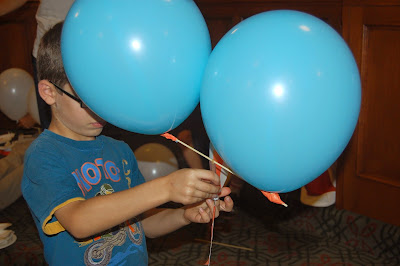The Science Behind Making Music
This afternoon we had a program at Pasadena Library about how to make a musical instrument--something that would produce not just noise, but definite pitches that you could change or manipulate. We learned about aerophones, chordophones, idiophones and membranophones, and then got a chance to make our own DIY instruments.
Here was my setup:
Not shown: a large container of water, which we needed for some of the instruments.
First, we talked about the properties of sound and experimented with a "head harp," which is made by putting a string through a wire hanger and holding both ends up to your ears to hear what sounds it made when we let the hanger hit the wall. Without the strings being close to your ears, all you hear is a faint click, but when the strings are held up to your ears it sounds like a gong or a church bell. This helped to convey a lesson about how much faster and better sound moves through solids than through air.
After some more discussion about how musical instruments work we made a turkey baster flute inspired by the awesome book Howtoons: Tools of Mass Construction. (First mentioned in this previous post--now I can say used it!)
The flutes were not easy for the kids to master, because of the embouchure needed. Wasn't even easy for me to master and I've played lots of instruments in my life. But the kids had fun making them and wanted to take their turkey basters home to perfect their instruments.
Next we made craft stick harmonicas. I found great instructions on this blog: http://mayamade.blogspot.com/2010/07/diy-harmonica.html. The hardest part of this project was wrapping the first rubber band around the craft stick without it snapping back at you! But if you get that far it's smooth sailing :)
I always try to pack my programs with informational learning. Here are my slides, hope they might be helpful:








Comments
Post a Comment